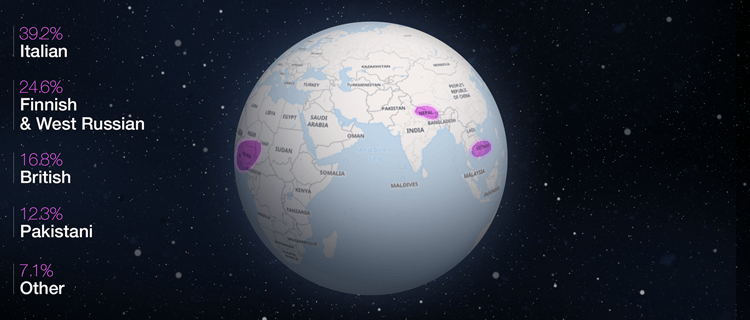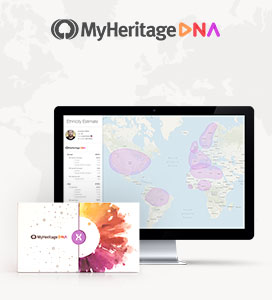Hvad er etnicitet

How are ethnicities used in DNA test results?
Ever wondered where you actually come from? Taking a DNA test can give you an accurate breakdown of which regions of the world your ancestors came from. People inherit half of their ethnicity from their mothers and half from their fathers, through their DNA, who in turn inherited half of their DNA from each of their parents, and so on, back in time. That means that decoding a person’s DNA allows us to see a small piece of the DNA of all of the ancestors who came before them. The more distant the relative, the smaller the DNA section they contributed, but it’s all there.
You may know about some of the ethnic groups associated with your family line through family stories. Or your relatives may also know a lot about where your ancestors settled and migrated to and from. One way to accurately find out exactly which geographical areas your forebears came from — to confirm oral histories or to fill in the gaps — is to take a DNA test. Even if you think you know a lot already, you may discover surprises!
You may know about some of the ethnic groups associated with your family line through family stories. Or your relatives may also know a lot about where your ancestors settled and migrated to and from. One way to accurately find out exactly which geographical areas your forebears came from — to confirm oral histories or to fill in the gaps — is to take a DNA test. Even if you think you know a lot already, you may discover surprises!
What is ethnicity?
DNA testing can reveal your family’s roots, going back around 6-9 generations. The ethnic groups identified in your DNA results are based on categories of people with common ancestral roots, who share the same language, culture and social mores. DNA results usually give you an idea of your ethnic origins by breaking down your ethnicity into percentages.
For example:
Sometimes, specific countries are identified; in other cases, a region, such as Scandinavia, comes up.
Ethnicity detection can be done because generations ago, people didn’t move as much as we do today. They didn’t fly cross-country or across oceans. Most people married and died in the same region where they were born. Because people married other people from the same region, and had children who then married in the same region, a correlation between DNA and geographic location arose. This was especially true for geographically isolated places like the island of Ireland.
Sometimes, this insular DNA inheritance wasn’t necessarily geographic — it may have been cultural. For example, Ashkenazi Jews or Mennonite Christians married and had children within their own groups, generation after generation, creating a correlation between their DNA and their cultural identity.
For example:
- 70% British,
- 20% German,
- 10% Nigerian.
Sometimes, specific countries are identified; in other cases, a region, such as Scandinavia, comes up.
Ethnicity detection can be done because generations ago, people didn’t move as much as we do today. They didn’t fly cross-country or across oceans. Most people married and died in the same region where they were born. Because people married other people from the same region, and had children who then married in the same region, a correlation between DNA and geographic location arose. This was especially true for geographically isolated places like the island of Ireland.
Sometimes, this insular DNA inheritance wasn’t necessarily geographic — it may have been cultural. For example, Ashkenazi Jews or Mennonite Christians married and had children within their own groups, generation after generation, creating a correlation between their DNA and their cultural identity.
How is ethnicity different from race?
Traditionally, people who are said to be of the same race have similar physical features and a common ancestry. For example, people whose origins are in China often have a specific facial features that are common to people from that region.
More and more, however, people are becoming interested in their ethnic background in terms of geographical origins, going beyond the commonality of any physical features they may have. Ethnicity describes a geographical region with common traditions and a common language, as well as an ethnic group that shares similar ancestral roots.
More and more, however, people are becoming interested in their ethnic background in terms of geographical origins, going beyond the commonality of any physical features they may have. Ethnicity describes a geographical region with common traditions and a common language, as well as an ethnic group that shares similar ancestral roots.
How do DNA tests identify your ethnic groups?
An ethnicity test can give you deep insight into your ethnic background, going beyond your family tree and family folklore. Many people are surprised by the ethnicities that are listed in their DNA results. On average, one human’s DNA is 99.5% the same as another human, so there are more genetic similarities than differences. However, by looking closely at the sections known to differ from one person to the next, and comparing it to that of various ethnic groups, your ethnic origins can be identified.
The future of DNA testing and ethnicity
The size and accuracy of the ethnicity estimates offered by DNA companies via genetic testing is improving all the time. Still, already, DNA testing is a fun, easy, and effective way to gain more insight into your family history and the journeys of your ancestors that led to where you are now.

